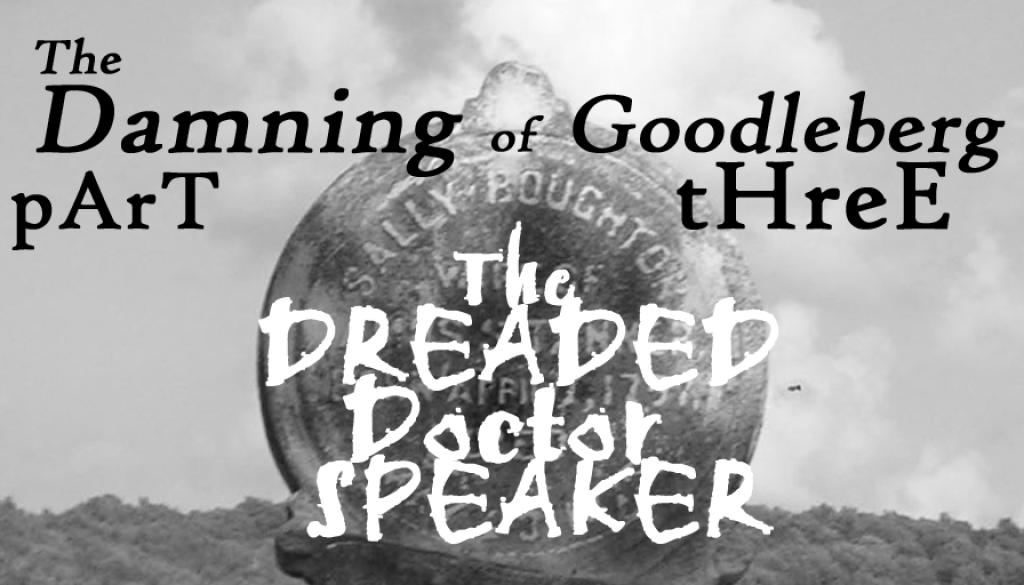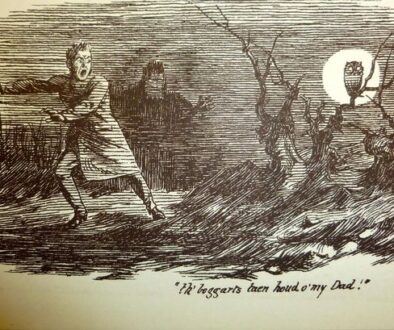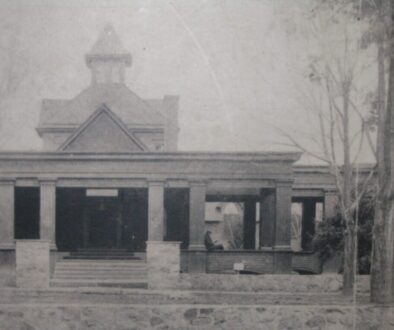The Damning of Goodleberg, Part 3: The Dreaded Doctor Speaker
Yes, it’s that time of year again. The summer months are on us and here come the ghost-hunters. It’s sure to get hot at the top of that hill holding the most prominent outdoor haunt on the Niagara Frontier and surely one of the most notorious, devastated, scandalous burying-grounds in New York State. Hold onto your hats, it’s Goodleberg…! AIEEEEEEEEE!!!!!
Our first article in this series was a general survey of the troubled graveyard, and in it I conjectured that Goodleberg’s shocking and disproportionate folkloric impact could be due to the closeness of its rumors to its truth. The second was an evaluation of its apparition-forms, its reported ghosts. In this one, maybe we should focus on what we know about the root of many of the legends, the dreaded “Dr. Speaker,” and a few of the threads that radiate from there.
“Medical Examiner” (likely “coroner”) Albert Speaker (1880?-1948) seems to have been the son of first-generation immigrants from some Germanic nation, probably Austria. He may have come to the United States as an infant. The grown Dr. Speaker had offices in Buffalo and at least one residence in Wales, on Hunter’s Creek Road, not far from its intersection with Goodleberg Road (a hilly half-mile or so from the fabled cemetery). His house still stands, and some of the locals can tell you where, though I won’t.
I am told by an M. D. friend that Speaker’s title was no esteemed one in the medical profession. Maybe that was why he got into alternate venues. It was apparently common knowledge in the day in these parts of Holland and South Wales that if you got a girl into a bad way, Dr. Speaker was a good guy to know. And you needed somebody good in an era in which abortions were both covert and medically dangerous.
Speaker, though, was said to be more than just an abortionist. He was a guy who made problems go away. The fetal corpses, the bodies of the inevitable mothers-to-be who passed away under his ministrations… Speaker was rumored even to have been a potential killer, and beyond that someone who had a terrible and unnatural fascination with the body parts of women. (His house was searched after his death, and some strange and disturbing things were reportedly found.) Surely I need to go no further, other than to say that Town of Wales historians told me that at a meeting in 1997.
After his questioning in a locally prominent disappearance-murder case, Speaker exited this world in early October 1948. The papers of the day tell us that he passed due to a heart attack, but the historians I spoke to at the same 1997 meeting believe the papers were soft-pedaling it, which was quite common for the day, and that Speaker took his own life. No wonder. That life would not have been worth living if what he was suspected of turned out to be true. His private predilections would have been unsurvivable in any sense.
Speaker had several siblings. Some of them survived him and took his body to New York City where he is buried today.
We catch a whiff of intrigue of another sort with Dr. Speaker. Sometimes – it was said – “crime elements” brought people to Dr. Speaker. I don’t know what to make of this assertion, or the local buzz that those hills just over today’s Route 16 had some pattern of mob activity – hideouts, safe houses, vacation homes, etc. (If that’s true it seems inconsistent with other developments. For instance, it would be ludicrous to call attention to the region of a safe house by causing any sort of trouble anywhere nearby.)
As if all this wasn’t enough, there appears to be a connection between this doctor, the road, and at least one mid-20th century murder, which is doubtless why the investigation came to him.
A “beautifully furnished” home on Hunter’s Creek Road was visited by the police a few weeks after the August 1948 disappearance of Mrs. Helen Lindeman – the wife of a Kenmore, NY, dentist. Though his name never appears in the newspaper reports we have seen, we presume from later developments that the site was Speaker’s. By early October of 1948 the occupant of the home had died – “of a heart attack” (say the papers). Someone torched the deserted house that same year on the weekend of Halloween. Evidently someone besides Dr. Speaker had something to hide.
The case involving Helen Lindeman is a study in itself and sometimes referred to as the first of “the Lindeman Murders.” Between 1948 and 1951 three Buffalo-area women were abducted, killed, and dumped naked in various parts of the Niagara Frontier. Mrs. Lindeman was the first.
The murder of the second, a Cheektowaga woman found in Ellicott Creek, was quickly solved. The perpetrator was judged to be her husband. The third was a former WAC (Women’s Army Corps) veteran found beneath a lakeside cliff in the Town of Hamburg. This case fit the rather straightforward pattern of a sex-killing, probably at the hands of a stranger. Unless there’s more that we will likely never know, the only link between the three murders may be the profile of the victims – attractive, married, thirty-something – which is surely why a few reporters presumed they spotted a link. And neither of the latter two should be connected to Dr. Speaker or Goodleberg. These two took place after Dr. Speaker’s death, and a long way away from the troubled cemetery. The strangest case of them all was the first, and seemingly the only one with a link to the fabled burying-ground.
Helen Lindeman was the red-haired, 38-year-old wife of a prosperous dentist in Kenmore (one of Buffalo’s northern burbs) who gave her name (probably erroneously) to the apparent cycle. On August 21, 1948, she walked out of her house on an afternoon errand and never returned. She must have known and even gone willingly with whoever transported her. The prospect of a daylight strong-arm abduction in that nurturing village seems remote. The last reported sighting of her was around six in the evening, and she looked untroubled.
The authorities started circulating her description and calling for leads. Her husband the dentist endured long grillings from the police and passed with flying colors. Reports of women who looked like Mrs. Lindeman came in from far-flung parts of Erie County.
As more attention drew to the case, three people in Delevan recalled seeing an abstracted woman in black clothing walking along Route 16 and possibly soliciting a ride. The woman seemed to be headed north, toward Chaffee and back toward Holland/Goodleberg. They may even have reported this to the police the day of the sighting, which was soon after Helen Lindeman’s disappearance in Kenmore but well before her death. One of the Delevan folk later saw a picture of Mrs. Lindeman and felt sure “the woman in black” was she. A Wales farmer recalled seeing what should have been the same woman – black-garbed, russet-haired, nervous – on Hunter’s Creek Road a few weeks later, followed by a slow-moving car that she may have entered. After this, it’s all surmise.
Five weeks after her disappearance Mrs. Lindeman’s body parts were found along Hunter’s Creek Road, a hike away from Goodleberg. (They were so badly decomposed that any sightings of her in preceding weeks could have been her ghost.) A week after that, her torso and then her head were found in Ischua and Riceville, respectively, two sparsely-populated areas of Cattaraugus County. (Ischua is right off of Rt. 16 not far from Olean, probably forty minutes south of Goodleberg. Riceville is about twenty minutes west and south of Goodleberg and a bit south of Springville.) Someone must have had quite the late-night joyride. It was presumed from the positioning of some of the remains that two people must have been pitching body-parts out the windows on either side of a moving vehicle.
Mrs. Lindeman’s head had been worked over by dogs and left in the middle of a road. Her dentist-husband had to identify it by her teeth. Fingerprint tests were later applied to other bits of her that were found and determined to confirm her identity.
So “Doc” Speaker died in early October 1948. This was not long after the Lindeman murder was discovered, but well before he could have done the others.
Though the three women’s murders seemed related to a Buffalo reporter in January 1952, I wonder if they really were. The modus operandi of the killings was different, which I hear is most significant. Nevertheless, “the Lindeman Murders” are in the local folklore, named for the first victim – which also connects them to Speaker. He may have been suspected as a party to sheltering her in his home. He may have been suspected of involvement in her death and dismemberment.
So much for Dr. Speaker. The Lindeman family has its own connections to intrigue, making us wonder about the activities of the pater familias, Dr. Howard Lindeman. It seems that Dr. Lindeman married again after the loss of his ill-fated first wife. Two years after her passing, Dr. Lindeman and his second family had a son for whom a very similar fate waited.
Buffalo businessman Ralph Lindeman was 46 when he disappeared in November 1996. He lived in Buffalo’s Allentown District at the time. Two years later, a rabbit hunter came upon his skull – severed from the rest of his body – in a wooded area off Mix Road near Albion, NY. Law enforcement officials called this one of the strangest cases they had ever worked on.
Lindeman’s only known connection to Orleans County was owning a few of its rural acres. His connection to trouble may have been more significant. The best clue to what Lindeman thought he was in for was contained in a letter written but never mailed to his family. He wrote, according to the Buffalo News, that he was in big trouble with “the mob, guns, drugs, sex, etc…” He alluded to “a problem” that he thought he had solved but that, if he had not, “someone would die.” That someone would appear to have been him.
Law enforcement officials believed Lindeman was beaten, robbed of $100,000, strangled, dismembered in an attempt to make his body harder to identify, and then dropped off in the woods of Orleans County a mile or two south of Route 31A.
One Buffalo man was sent to prison for this crime. A second suspect in the case will probably never be punished unless new evidence turns up. But the suggestion of a link to organized crime permeates both Lindeman cases and that of Goodleberg’s Dr. Speaker. That could be the critical variable, but, so many years later, I doubt we will ever be sure.
Goodleberg’s immediate region can’t escape its own intrigue. The year after the Speaker affair when the snows withdrew, a hunter found a man’s body in a ravine behind Speaker’s former house. He had been dead a long time. The full winter had hurled over him and kept him whole in its snowy womb. His hair had grown.
Possibly hoping to come up with a bone for a ritual, someone dug a six-foot cone into the Goodleberg grave of little May Agnes Doster (buried in 1895) on April 30, 2000. This is May Eve, another of the four Celtic power-nights and a traditional witches’ sabbath.
And of course there was the young ghost hunter struck and killed by a car while visiting Goodleberg on June 21, 2003. This was the Summer Solstice, a power-night around the world. Young Robert Carr was an associate of the Paranormal & Ghost Society, and the incident was traumatic for the region’s budding paranormal community.
The next article, the fourth in our series, contains my own comically unhappy brush with Goodleberg, should I have the guts (or lapse of judgment) to write it. Stay tuned. I have another week to meditate on it.





October 5, 2021 @ 8:35 pm
Do you know the names of the other 2 women mentioned above?
December 22, 2021 @ 5:30 pm
My parents were born in 1909 and 1916. My dad met Dr. Speaker when doing collision work on his car. They used to attend parties at his home. When looking for a country home, we looked at the Speaker house unknowingly. I remember describing the property and my father knew what we looked at. My parents proceeded to tell us the stories. Needless to say, we didn’t buy the house.